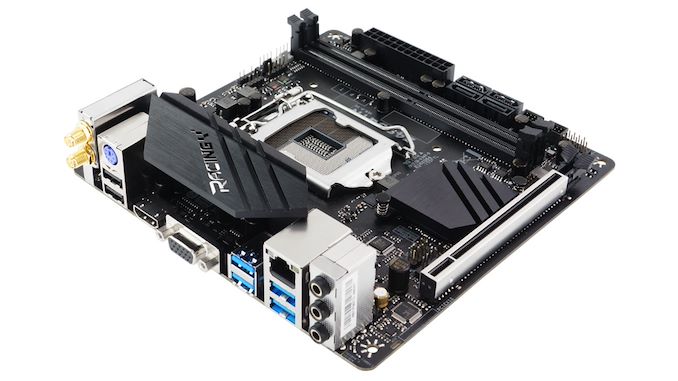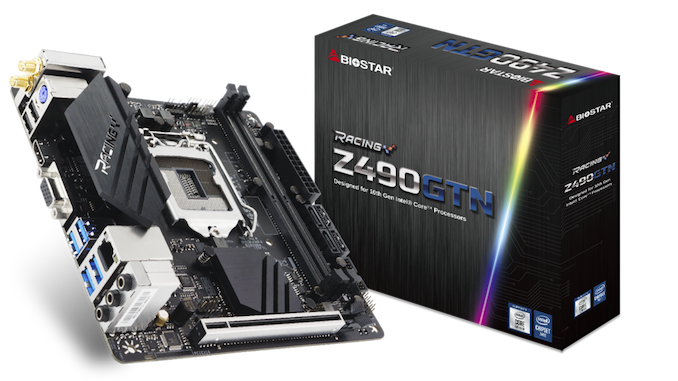The Biostar Racing Z490GTN Review: $200 for Comet Lake mini-ITX
by Dr. Ian Cutress & Gavin Bonshor on June 5, 2020 10:00 AM EST- Posted in
- Motherboards
- Intel
- Biostar
- Z490
- 10th Gen Core
- Comet Lake
- Z490GTN

Small form factor boards are always a key talking point for any desktop market. The usual breakdown on Mini-ITX sales for any given generation is usually around 10%, and because these boards end up in the lower-cost systems, there tends to be a focus on the cheaper end of the spectrum, even when it comes to the Z series chipset which is the one with all the bells and whistles. With Intel's new Comet Lake-S processors, ranging from Celeron all the way up to Core i9, and with the new socket for Comet Lake, there will be a renewed demand for those looking to build a small form factor Intel system. One of the popular mini-ITX low-cost boards in each generation is from BIOSTAR, and today we're testing the Z490GTN.
Building the Biostar Battleship
All the arguments for building a small form factor system have been discussed ad nauseum: the home theatre mini PC (HTPC), the small form factor gaming machine, the single-use server option, or the low power desktop or work machine. Throughout the decade, motherboard companies have varied between low cost mini-ITX designs, saving a lot of pennies in design, all the way to the high performance, high cost, flashy models that cost more than a lot of decent ATX full-sized motherboards. We can see these motherboards, on Z-series chipsets, range from $120 to $350+, and it is an interesting exercise to see what price segments end up being promoted in which generation.
With the new Z490 chipset, Biostar has gone for a more mid-range design in the Z490GTN. This $200 model is in the price bracket often seen as hyper-competitive. At that price, it's perhaps too-high for a basic system (wait for the B-series chipset version), which means that Biostar has to make an effort to provide enough mid-range features to make the motherboard worthwhile. With the Z490GTN, the key highlights include a PCIe 3.0 x4 NVMe slot, helpful connector and header placement (often an issue on these sized boards), a reinforced PCIe 3.0 x16 slot, and support for 64 GB of DDR4-4000.
The GTN range of Biostar mini-ITX boards have been popular over the years, often due to their simplicity and the price. There's nothing substantially excellent about these boards - they seem to be able to function and provide a no-nonsense implementation. The Z490GTN is one such example, implementing a simple 6+2 phase design on the power delivery, SATA ports that don't block each other when using angled connectors, support for legacy connectivity, an Intel gigabit ethernet controller, and budget Realtek audio. One thing I should point out that while Biostar states that this motherboard has the ability to support Wi-Fi 6, it is only though an add-in card, which is not bundled with the motherboard.
Biostar is keen to promote its use of higher density pin connectors in the 24-pin ATX and 8-pin 12V connections, which the company says reduces in-wire resistance and therefore offers a lower wire temperature, leading to fewer issues with pin degredation. It seems that perhaps Biostar's motherboards are used in locations where this is an issue, such as high-humidity countries or in countries where the room temperature is 30ºC+ (often these locations go together, too).
Results Summary
On the whole, we saw no major surprises from the Biostar Z490GTN, and it retained a good deal of competitiveness against our other Z490 platforms. Out of the boards tested so far, the Z490GTN scored its main win in idle power, which is often a key element for these small form factor motherboards. Everything else was within margin with other motherboards.

Overclocking and thermals with a mini-ITX board is often a key battleground, as it balances good design with good firmware as well as how much is spent on the power delivery and cooling.
As part of this test, we tested with two BIOSes (514 and 522), and the 522 results were higher but it came at the expense of worse thermals. They both gave high VRM temperatures, above 85ºC+. This is one area where a $200 mini-ITX board doesn't seem to cut it - we saw a +36ºC delta compared to the bigger, more expensive ATX boards, using our 8-core Comet Lake CPU set to 5.1 GHz all-core. At these temperatures we were even riding the rails of stability in our overclock. Even though this motherboard is a Z490, and one of the benefits therein is going to be the ability to overclock, perhaps this isn't the best board to do it.
Overall this board has potential, and it's worth digging into the details to find out if this is the right motherboard for you.
Motherboard Tested by Gavin Bonshor.
Overview, Visual Inspection, and Conclusion by Ian Cutress.
Other pages written by Gavin Bonshor.













40 Comments
View All Comments
YB1064 - Friday, June 5, 2020 - link
$200 for this board is ridiculous.boredsysadmin - Friday, June 5, 2020 - link
100%. Since when $200 is a "budget" price point for a motherboard????shabby - Friday, June 5, 2020 - link
The itx crowd will pay don't worry.HardwareDufus - Friday, June 5, 2020 - link
no we won't pay for it.1 m.2 port, no wifi, no dp, no optical audio... sorry... expensive and incomplete.
shabby - Friday, June 5, 2020 - link
Oh you'll pay and you'll like it! 😂Samus - Saturday, June 6, 2020 - link
It isn't terrible for $200 but the little things like skimping on the audio codec (that couldn't have saved more than a dollar or two, right?) really sour an ITX board when you consider there is no way to upgrade it outside of a USB DAC (which is fine for most applications, but another expense.)I purchased an Asrock Z97 ITX board a few years ago for $115 bucks at Microcenter. This is the modern day equivalent for almost double the price. To add insult to injury, the Asrock board DID have an ALC1150 codec AND 802.11ac included.
Why are motherboards getting so expensive when the chipsets and component costs are becoming simpler and less expensive?
Ej24 - Sunday, June 7, 2020 - link
Was going to say the same thing. I have 3 Z97 itx motherboards. All purchased brand new for $120. What is going on? Inflation hasn't been THAT crazy to nearly double costs. Tariffs perhaps?Samus - Monday, June 8, 2020 - link
It could actually be tariffs...this is a new trend that started after the 100 series chipsets. Even AMD boards cost a small fortune now, even more ridiculous since the chipset is almost entirely in the CPU. The board is little more than voltage regulation, tracing and connectors...alicebcao75 - Monday, June 8, 2020 - link
Make 6150 bucks every month… Start doing online computer-based work through our website. I have been working from home for 4 years now and I love it. I don’t have a boss standing over my shoulder and I make my own hours. The tips below are very informative and anyone currently working from home or planning to in the future could use this website. WWW. iⅭash68.ⅭOⅯFamous12 - Monday, September 21, 2020 - link
https://customerfeedback.onl/Share your visit experience at www.Shoecarnival.com/Feedback & grab the Chance to Win a $200 Shoe Carnival Gift Card by entering into Shoe Carnival Sweepstake.